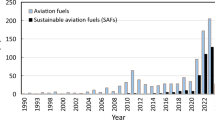Abstract
Minimum fuel, three-dimensional trajectory optimization from a parking orbit considering the desired landing site is addressed for soft lunar landings. The landing site is determined by the final longitude and latitude; therefore, a two-dimensional approach is limited and a three-dimensional approach is required. In addition, the landing site is not usually considered when performing lunar landing trajectory optimizations, but should be considered in order to design more accurate and realistic lunar landing trajectories. A Legendre pseudospectral (PS) method is used to discretize the trajectory optimization problem as a nonlinear programming (NLP) problem. Because the lunar landing consists of three phases including a de-orbit burn, a transfer orbit phase, and a powered descent phase, the lunar landing problem is regarded as a multiphase problem. Thus, a PS knotting method is also used to manage the multiphase problem, and C code for Feasible Sequential Quadratic Programming (CFSQP) using a sequential quadratic programming (SQP) algorithm is employed as a numerical solver after formulating the problem as an NLP problem. The optimal solutions obtained satisfy all constraints as well as the desired landing site, and the solutions are verified through a feasibility check.
Similar content being viewed by others
References
C. M. Akridge and S. H. Harlin, “Parametric performance analysis of lunar missions, part II: lunar descent,” Tech. Rep. MTP-P&VE-F-63-8, NASA, George C. Marshall Space Flight Center, Huntsvillie, AL, February, 1965.
F. V. Bennett and T. G. Price, “Study of powered descent trajectories for manned lunar landings,” Project Apollo Working Paper 1084, NASA Manned Spacecraft Center, Houston, TX, August, 1963.
J. S. Meditch, “On the problem of optimal thrust programming for a lunar soft landing,” IEEE Trans. on Automatic Control, vol. 9, no. 4, pp. 477–484, October 1964.
C. R. Cavoti, “Minimum-fuel, two-impulse, soft lunar landing orbits,” Tech. Rep. NASA CR-65554, Space Sciences Laboratory, General Electric Company, September 1996.
R. V. Ramanan and M. Lal, “Analysis of optimal strategies for soft landing on the Moon from lunar parking orbits,” Journal of Earth System Science, vol. 114, no. 6, pp. 807–813, 2005.
L. Tu, J. Yuan, J. Luo, X. Ning, and R. Zhou, “Lunar soft landing rapid trajectory optimization using direct collocation method and nonlinear programming,” Proc. of SPIE, the International Conf. on Space Information Technology, pp. 67954T.1–67954T.6, 2007.
M. Hawkins, Constrained Trajectory Optimization of a Soft Lunar Landing from a Parking Orbit, Master’s thesis, Massachusetts Institute of Technology, 2005.
M. Ross, “User’s manual for DIDO (ver. pr.1β): a Matlab application package for solving optimal control problems,” Tech. Rep. 04-01.0, Naval Postgraduate School, Monterey, CA, February 2004.
F. Fahroo and I. M. Ross, “Costate estimation by a legendre pseudospectral method,” Journal of Guidance, Control, and Dynamics, vol. 24, no. 2, pp. 270–277, March–April 2001.
M. Ross and F. Fahroo, “Pseudospectral knotting methods for solving optimal control problems,” Journal of Guidance, Control, and Dynamics, vol. 27, no. 3, pp. 397–405, May–June 2004.
C. Lawrence, J. L. Zhou, and A. L. Tits, “User’s guide for CGSQP version 2.5: a C code for solving (large scale) constrained nonlinear (minimax) optimization problems, generating iterates satisfying all inequality constraints,” Univ. of Maryland, College Park, MD, 1997.
L. Meriam and L. G. Kraige, Dynamics, Engineering Mechanics, 3rd ed., John Wiley and Sons, Inc., New York, New York, 1992.
Q. Gong, W. Kang, N. S. Bedrossian, F. Fahroo, P. Sekhavat, and K. Bollino, “Pseudospectral optimal control for military and industrial applications,” Proc. of IEEE Conf. on Decision and Control, pp. 4128–4142, December 2007.
H. Schaub and J. L. Junkins, Analytical Mechanics of Space Systems, AIAA Education Series, American Institute of Aeronautics and Astronautics, Inc., Reston, Virginia, 2003.
S. Josselyn and I. M. Ross, “Rapid verification method for the trajectory optimization of reentry vehicles,” J. Guidance, vol. 26, no. 3: Engineering notes, pp. 505–508, November 2002.
G. Elnagar, M. A. Kazemi, and M. Razzaghi, “The pseudospectral legendre method for discretizing optimal control problems,” IEEE Trans. on Automatic Control, vol. 40, no. 10, pp. 1793–1796, October, 1995.
E. Brayson and Y. C. Ho, Applied Optimal Control — Optimization, Estimation and Control, Hemisphere Publishing Company, New York, 1975.
Author information
Authors and Affiliations
Corresponding author
Additional information
Recommended by Editor Hyun Seok Yang.
This work was supported by NSL (National Space Lab) program through the Korea Science and Engineering Foundation funded by the Ministry of Education, Science and Technology (2008-2003184).
Bong-Gyun Park received his B.S. degree in Mechanical and Aerospace Engineering from Gyeongsang National University in 2008. He received his M.S. degree in Aerospace Engineering from KAIST in 2010. He is currently pursuing a Ph.D. degree in Aerospace Engineering from KAIST. His research interests include trajectory optimization, missile guidance, and terrain relative navigation.
Min-Jea Tahk received his B.S. degree in Aeronautical Engineering from Seoul National University in 1976, and his M.S. and Ph.D. degrees in Aerospace Engineering from the University of Texas at Austin, in 1983 and 1986, respectively. He was a Researcher Engineer at the Agency for Defense Development, Daejeon, Korea, from 1976 to 1981, and Research Scientist at Integrated Systems, Inc., Santa Clara, CA, from 1987 to 1989. He is presently a professor in the Department of Aerospace Engineering of KAIST. His research interests include missile guidance, pursuit-evasion games, autopilot design, collision avoidance, and evolutionary optimization techniques.
Rights and permissions
About this article
Cite this article
Park, BG., Tahk, MJ. Three-dimensional trajectory optimization of soft lunar landings from the parking orbit with considerations of the landing site. Int. J. Control Autom. Syst. 9, 1164–1172 (2011). https://doi.org/10.1007/s12555-011-0618-0
Received:
Accepted:
Published:
Issue Date:
DOI: https://doi.org/10.1007/s12555-011-0618-0




